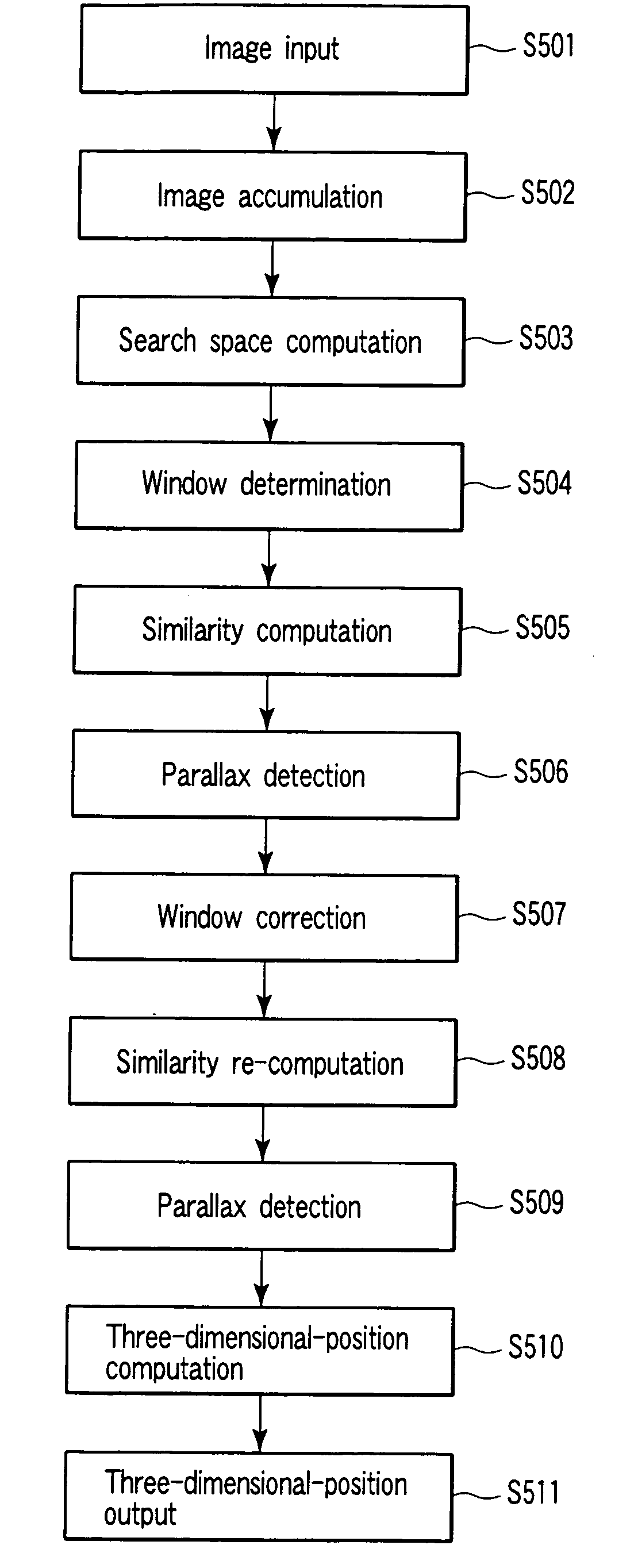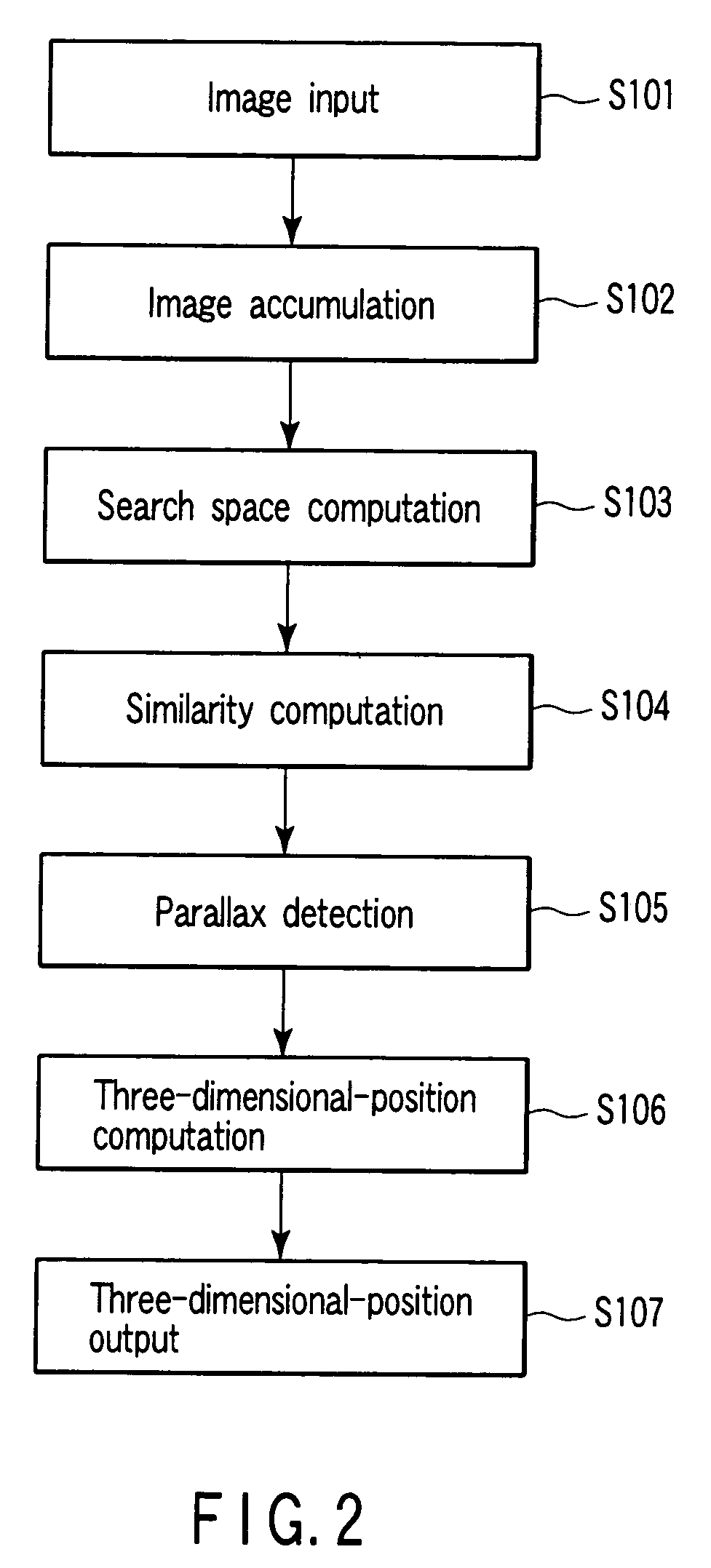Three-dimensional-information reconstructing apparatus, method and program
a three-dimensional information and reconstruction apparatus technology, applied in the field of method and program, can solve the problems of insufficient studies on a three-dimensional information reconstruction apparatus capable of such real-time processing, no conventional three-dimensional information reconstruction apparatus that efficiently computes, and no sufficient studies have yet been performed on a high-resolution three-dimensional information reconstruction method
- Summary
- Abstract
- Description
- Claims
- Application Information
AI Technical Summary
Benefits of technology
Problems solved by technology
Method used
Image
Examples
first embodiment
[0050]FIG. 1 is a block diagram illustrating a three-dimensional-information reconstructing apparatus according to a first embodiment of the invention. As shown, the three-dimensional-information reconstructing apparatus comprises an image input unit 101, image accumulation unit 102, search space computing unit 103, parallax computing unit 104, three-dimensional-position computing unit 105 and output unit 106. The parallax computing unit 104 comprises a similarity computing unit 104a, parallax detection unit 104b and memory 104c.
[0051]The image input unit 101 is formed of a plurality of cameras having a function for capturing an object existing in three-dimensional space. For simplifying the description, assume here that the image input unit 101 is formed of two cameras located on the right and left sides in parallel with each other, as shown in FIG. 6. Namely, the central point of each of the lenses of the right and left cameras is set as the origin of the three-dimensional coordi...
second embodiment
[0129]In the first embodiment, the similarity computing unit 104a computes, for each of parallax candidates, the degree of similarity between each projected point included in a search range on a reference image, and the corresponding projected point on another image. However, to detect the three-dimensional position of or to reconstruct the three-dimensional configuration of an object whose image appears in an image captured by a camera, accurate parallax detection is performed concerning the object, while rough parallax detection is performed concerning the background of the object, thereby reducing the number of computations necessary to detect parallaxes. As a result, high-speed three-dimensional information reconstruction can be realized.
[0130]Consideration is given to a case where still image data is sequentially input from a plurality of cameras to the image input unit 101, and three-dimensional information is sequentially reconstructed from the still image data. In this case,...
third embodiment
[0149]In the first embodiment, the similarity computing unit 104a computes the degree of similarity between a projected point (x, y) on the reference image and the corresponding projected point (x′, y′) on the other image, by computing the normalized cross-correlation C (x, y, d) between a window of a predetermined size including the projected point (x, y), and a window of the same size including the corresponding projected point (x′, y′).
[0150]To accurately detect the projected point (x′, y′) on the other image corresponding to the projected point (x, y) on the reference image, it is desirable to use larger windows since they enable corresponding projected points to be detected based on a greater amount of data. However, if the windows contain a large number of regions having different parallaxes, erroneous correspondence of projected points may well occur. Therefore, it is desirable to set a window of an appropriate size for each projected point. For example, it would be advisable...
PUM
 Login to View More
Login to View More Abstract
Description
Claims
Application Information
 Login to View More
Login to View More - R&D
- Intellectual Property
- Life Sciences
- Materials
- Tech Scout
- Unparalleled Data Quality
- Higher Quality Content
- 60% Fewer Hallucinations
Browse by: Latest US Patents, China's latest patents, Technical Efficacy Thesaurus, Application Domain, Technology Topic, Popular Technical Reports.
© 2025 PatSnap. All rights reserved.Legal|Privacy policy|Modern Slavery Act Transparency Statement|Sitemap|About US| Contact US: help@patsnap.com



